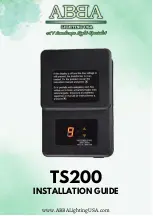
M1XRFTWM Installation Manual
Page 5
Setting the Data Bus Address and the Starting Wireless Zone ID
The Transceiver must be addressed and enrolled as the 1st zone expander (Data Bus Address # 2) on the M1 Control
. For
extended range/coverage up to 3 additional Transceivers may be installed so long as they are enrolled as the 2nd, 3rd, and 4th
zone expander ONLY (Data Bus Addresses 3, 4, and 5) on the M1 Control. If another hardwire or wireless expander is presently
enrolled at one of these addresses that device must be moved to another address in order to make room for the Transceiver.
Refer to Appendixes A, B, & C for more details on the use of multiple transceivers.
Data Bus Address Information
: Every device attached to the M1 Data Bus must have a valid address setting within it's device
type. TYPE 1 is for Keypads, TYPE 2 is for Hardwire and Wireless Input expanders, TYPE 3 is for Output expanders, TYPE 5 is
for Serial expanders. This grouping of devices into different device types allows reduces the required number of address numbers
as it allows devices in different groups to share the address numbers. All devices other than keypads utilize a bank of 4 miniature
DIP switches for setting their address number. Each switch has an OFF or ON position (binary value 0 or 1) and decimal equiv.
value of (1, 2, 4, or 8). The total decimal value of the "ON" switches determines the data bus address. Set the switches to the
desired data bus address by referring to Tables 1-1 and 1-2. A small screwdriver may be helpful.
Hardwired Expanders versus Wireless Expanders (Transceivers):
A single Hardwired Zone Expander adds 16 hardwired zones at a time to an M1 Control. The data bus address determines the
zones numbers (starting and ending) of that group of 16 zones. See Table 1-1 and 1-2. If additional M1XINs are installed each
must be assigned a different address, usually the next available, which sets the zone numbers (starting and ending) of that group
of 16 zones.
A single Wireless Transceiver/Zone Expander can add up to 144
wireless zones to an M1 Control.
The primary Transceiver
must be installed and enrolled at data bus address #2 and the first wireless zone will always be Zone 17. If the full compliment of
144 wireless zones is installed, the last wireless zone would be Zone 160.
No wireless Zones may exist beyond Zone 160.
No hardwired zone expander should ever be assigned a data bus address that would result in a conflict between a wireless zone
and a hardwired zone. In a mixed system of hardwired and wireless zones if any hardwired zone expanders are enrolled in the
range of zones 33 through 160 then an entire group of 16 wireless zones is lost for every hardwired (16 zone) expander installed.
1. Mounting
- Use two (2) #6 x 1/2" screws (not provided) on each side of the housing for mounting. The Transceiver connects
to the Keypad data bus and may be remotely located up to several thousand feet away from the control. NEVER mount inside
a metal enclosure or on metalized surface! Space at least 4 to 6 feet from electrical devices that generates noise, including
the M1 Control. Electrical noise may negatively affect operation.
2. Wiring Connections
- Turn the power Off on the Control Panel before making any wiring connections. Connect terminals
+12V, A, B, and Neg from the transceiver to the M1's Keypad Data Bus (terVKP, Data A, Data B, & Neg).
NOTE: Refer to the M1 Installation Manual and the M1DBH information in that manual about proper con-
nections of data bus devices with multiple homerun cables.
3. Antenna - This device uses a single on-board ceramic antenna. No external antenna is required.
Diagnostic LED Indicators
There are four (4) LEDs on the board that provide valuable information as to the operation of the Transceiver:
STATUS
(Data Bus Status) - Multiple conditions exist for this LED:
OFF = No Power to the unit.
ON Solid = Power is good but it is not yet enrolled with the M1 or the Microprocessor is not functioning.
BLINKING = 2 different blink rates:
- Slow "one blink per second" indicates Normal Operating mode.
- Two blips with brief off indicates Bootloader mode. Unit needs to be flash programmed with application
firmware. Unit will not be operational until application firmware has been flashed into the unit using ElkRP.
LEARNED RF
- This LED indicates that a valid transmitter has sent a signal packet back to the M1 Control.
ALL RF
- This LED blinks whenever any transmission is detected in the same frequency as the Transceiver.
DATA BUS ACTIVE
-
This LED blinks near continuously and indicates activity on the M1 Data Bus.


































